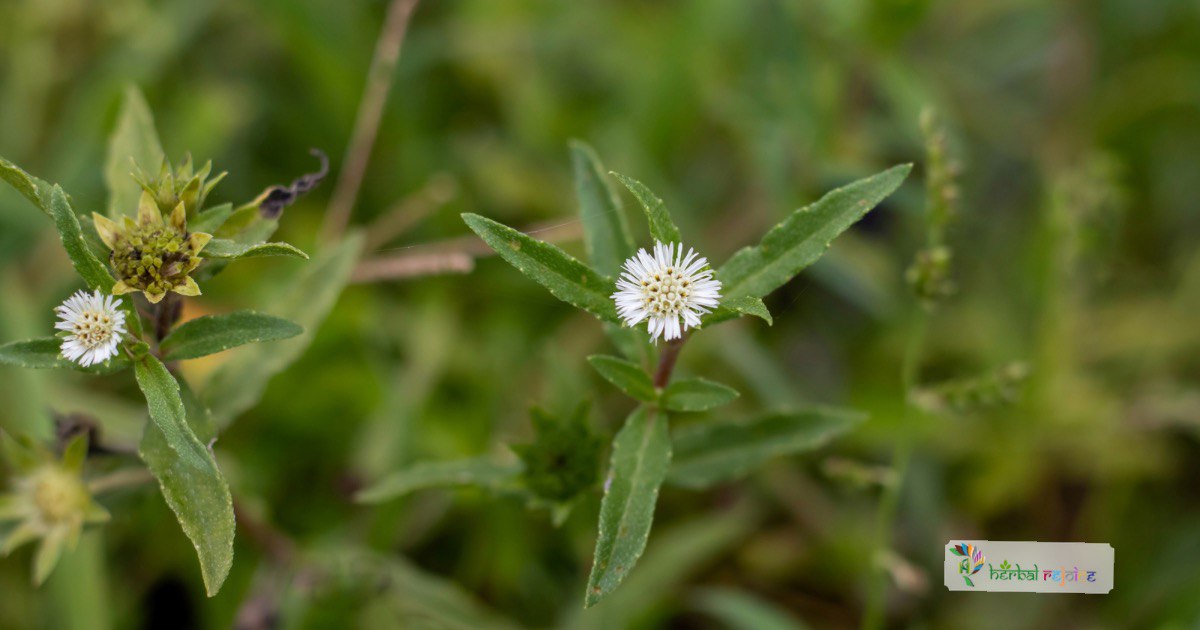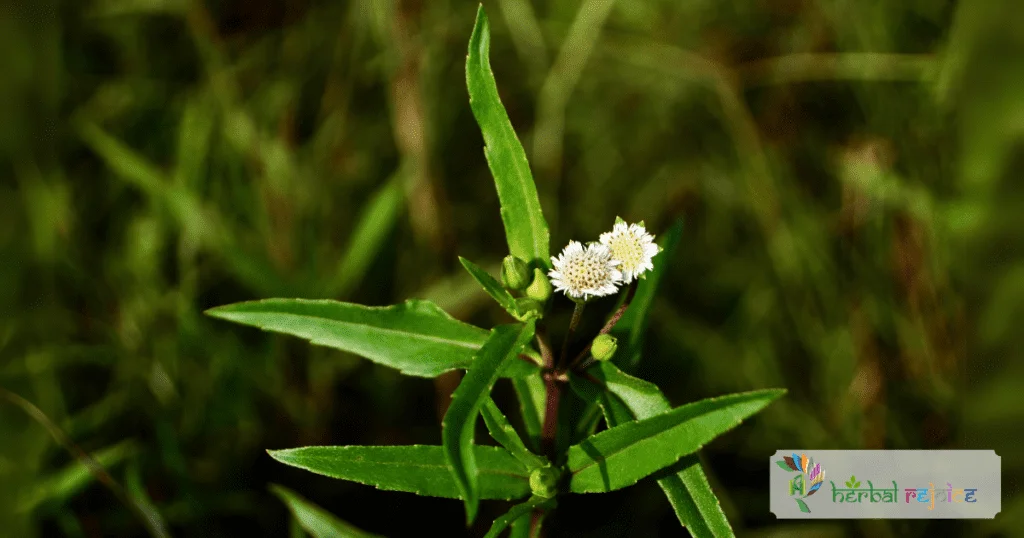Introduction to Bhringraj
Eclipta alba (Linn.) Hassk., commonly known as Trailing Eclipta Plant or Bhringraj, belongs to the Compositae/Asteraceae family.
This article will uncover the traditional uses and medicinal properties of Trailing Eclipta Plant in Ayurveda, Unani, Siddha, and folk medicine.
From its hepatoprotective and anti-inflammatory effects to its benefits in promoting hair growth, this article will showcase the extensive uses of this remarkable plant.
We will delve into the key components found in Trailing Eclipta Plant and their potential health benefits, while also highlighting dosage recommendations.
Join us as we explore the healing power of Trailing Eclipta Plant!
Names and Habitat:
Bhringraj(Trailing Eclipta Plant), scientifically known as Eclipta alba (Linn.) Hassk., is a plant belonging to the Compositae/Asteraceae family.
It can be found throughout India, growing in various regions, including hills up to 2,000 meters.
Traditional Uses and Medicinal Benefits Of Bhringraj
Trailing Eclipta Plant has a long history of use in traditional medicine, renowned for its diverse range of medicinal properties.
1. Hepatoprotective and Antihepatotoxic Effects:
The plant exhibits hepatoprotective and antihepatotoxic effects, making it beneficial for liver health.
It aids in the treatment of hepatitis and spleen enlargements, while also addressing chronic skin diseases.
2. Hair Growth Stimulation:
The leaves of Bhringraj are known for their ability to promote hair growth.
Extracts derived from the plant are applied to the scalp before bedtime to combat hair loss and improve hair health.
3. Anticatarrhal and Antipyretic Effects:
Trailing Eclipta Plant possesses anticatarrhal properties, helping to reduce excessive mucus production in the respiratory system.
It also exhibits febrifuge properties, aiding in the reduction of fever.
4. Other Medicinal Applications:
The plant is used in the treatment of peptic ulcers, inflammatory diseases like rheumatoid arthritis, gallbladder disorders, and skin infections.
Additionally, Trailing Eclipta Plant has been observed to have immunoactive properties against the surface antigen of hepatitis B-virus.
Key Components and Health Benefits Of Bhringraj
Trailing Eclipta Plant contains various components that contribute to its medicinal properties.
1. Wedelolactone and Demethylwedelolactone:
The plant contains wedelolactone and demethylwedelolactone, both of which have demonstrated potent antihepatotoxic effects.
These components protect the liver and aid in liver cell regeneration.
2. Thiophene Acetylenes:
The roots of Trailing Eclipta Plant are rich in thiophene acetylenes, which have shown activity against nematodes, making the herb effective against parasitic infestations.

Dosage and Recommendations:
The recommended dosage for Trailing Eclipta Plant varies depending on the form used.
1. Fresh Juice: Consuming 3-6 ml of fresh juice from the whole plant is advised.
2. Decoction: For decoction, 13-36 grams of the plant can be used.
Follow the guidelines provided in reputable medicinal texts for specific dosage instructions.
Conclusion:
Eclipta alba (Linn.) Hassk., commonly known as Bhringraj Plant, offers a myriad of medicinal benefits as showcased by its rich history in traditional medicine.
From its hepatoprotective and anti-inflammatory effects to its role in promoting hair growth, this plant has demonstrated its therapeutic potential.
The presence of wedelolactone, demethylwedelolactone, and thiophene acetylenes further enhances its medicinal properties.
Embrace the healing power of Trailing Eclipta Plant and unlock its natural benefits for your overall well-being.
Frequently Asked Questions (FAQs):
What is the scientific name for Trailing Eclipta Plant?
Trailing Eclipta Plant is scientifically known as Eclipta alba (Linn.) Hassk.
Where can Trailing Eclipta Plant be found?
Trailing Eclipta Plant can be found throughout India, growing in various regions, including hills up to 2,000 meters.
What are the traditional medicinal uses of Trailing Eclipta Plant?
Trailing Eclipta Plant has been traditionally used for its hepatoprotective and anti-inflammatory effects, promoting hair growth, treating hepatitis and spleen enlargements, addressing chronic skin diseases, and more.
Can Trailing Eclipta Plant protect liver health?
Yes, Trailing Eclipta Plant exhibits hepatoprotective and antihepatotoxic effects, making it beneficial for liver health and aiding in the treatment of liver conditions.
How does Trailing Eclipta Plant promote hair growth?
The leaves of Trailing Eclipta Plant contain properties that stimulate hair growth. Extracts derived from the plant can be applied to the scalp before bedtime to combat hair loss and improve hair health.
Does Trailing Eclipta Plant have any effects on respiratory health?
Yes, Trailing Eclipta Plant possesses anticatarrhal properties, reducing excessive mucus production in the respiratory system. It also exhibits febrifuge properties, aiding in the reduction of fever.
Are there any other medicinal applications of Trailing Eclipta Plant?
Trailing Eclipta Plant is used in the treatment of peptic ulcers, inflammatory diseases like rheumatoid arthritis, gallbladder disorders, skin infections, and has immunoactive properties against the surface antigen of hepatitis B-virus.
What are the key components found in Trailing Eclipta Plant?
Trailing Eclipta Plant contains wedelolactone, demethylwedelolactone, and thiophene acetylenes, all of which contribute to its medicinal properties, such as antihepatotoxic effects, liver protection, and activity against parasitic infestations.
How should Trailing Eclipta Plant be consumed?
Trailing Eclipta Plant can be consumed in the form of fresh juice or decoction.
Are there any known side effects of Trailing Eclipta Plant?
While Trailing Eclipta Plant has been used traditionally with minimal reported side effects.
Can Trailing Eclipta Plant be used during pregnancy or breastfeeding?
It is advisable to consult with healthcare professionals before using Trailing Eclipta Plant during pregnancy or breastfeeding, as individual circumstances and proper dosage guidance should be taken into consideration.
Can Trailing Eclipta Plant be grown in home gardens?
Trailing Eclipta Plant can potentially be grown in home gardens, depending on the growing conditions and availability of the plant.
Is there scientific research supporting the use of Trailing Eclipta Plant?
Trailing Eclipta Plant has been the subject of scientific research, supporting its traditional uses and demonstrating its potential medicinal benefits. However, further research is necessary to fully understand its mechanisms of action and efficacy.
Can Trailing Eclipta Plant be used alongside other medications?
It is recommended to consult with healthcare professional, Trailing Eclipta Plant with other medications to ensure there are no potential interactions or contraindications.
Is Trailing Eclipta Plant suitable for topical application?
Trailing Eclipta Plant can be applied topically to the scalp for hair growth stimulation. It is important to follow proper application methods.
How long does it usually take to see results from using Trailing Eclipta Plant for hair growth?
The time it takes to see results may vary depending on individual factors and consistency of use.
Can Trailing Eclipta Plant be used for pets?
It is recommended to consult with veterinarians before using Trailing Eclipta Plant on pets, as their dosage requirements and potential effects may differ from humans.
Where can Trailing Eclipta Plant products be obtained?
Trailing Eclipta Plant products, such as fresh juice or decoctions, may be available at specialized herbal stores.
Is there any advice for incorporating Trailing Eclipta Plant into a holistic healthcare regimen?
Proper dosage, guidance, and monitoring are crucial for safe and effective use.


